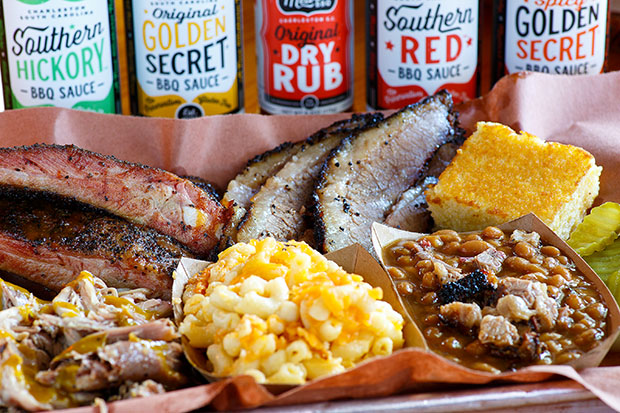What’s Hoppin’, John? And Pass the Oyster Pie!
09 Nov 2018
Every family has their holiday traditions, but travel back to find out the origin of Charleston’s ritual New Year’s Eve dishes
BY SUZANNAH SMITH MILES

Oyster pie on Christmas Eve and Hoppin’ John on New Year’s Day—these two Lowcountry food traditions are among the oldest and most delicious rituals of the holiday season. Like much of Charleston’s gastronomic history, they have origins based on easily procured local ingredients and, like Hoppin’ John, which hearken back to Africa and the Caribbean and were brought to the Lowcountry during slavery. While the dish first became popular in South Carolina, serving Hoppin’ John on New Year’s Day is now a tradition throughout the South.
Hoppin’ John is one of the top culinary delights of the Gullah tradition. As explained in the Lowcountry’s culinary bible, Charleston Receipts, first published by the Junior League of Charleston in 1950 (and still in print), “Hopping John, made of cow peas and rice, is eaten in the stateliest of Charleston houses and in the humblest cabins, and always on New Year’s Day. ‘Hoppin’ John eaten then will bring good luck’ is an old tradition.”
Indeed. No right-minded Charlestonian goes through New Year’s Day without a steaming plate of this rice and peas concoction, necessarily accompanied by collard greens and cornbread. You must eat Hoppin’ John on New Year’s Day. It brings good luck for the coming year. Likewise collard greens because they add the promise of money.
So who was John and why was he hopping? The background of the name has as many variables as there are recipes for this popular rice and field pea dish. One story says the name came from a lame Gullah street vendor (whose name, of course, was John), who sold servings of the dish from his cart on Charleston streets. Given his affliction, when he dished the servings out to his customers he necessarily “hopped” as he moved about. Another story attributes the name from hungry children eagerly hopping around the dinner table before eating.
Far more plausible (and likely the truth) is that the name came from a mistaken understanding and paraphrased Gullah version of the French word for field peas or pigeon peas, “pois pigeons,” which is pronounced “pwa-peejohn.” Say it aloud three times. Voila! Hoppin’ John!
Pigeon peas or black-eyed peas—Hoppin’ John recipes allow any kind of field pea, from cowpeas to Crowder peas and even kidney beans, depending on the geographic region where the dish is served. What is absolutely essential is that the peas are served with long-grained white rice. Some serve the rice and peas separately; other recipes call for the two to be cooked together.
The oldest Lowcountry recipes for Hoppin’ John call for adding fried bacon to the mixture. Today pork meats, such as ham hocks, salt pork or pork jowls are used. It all depends on the individual cook’s creativity. Historically, adding pork to the recipe is a New World tradition. In Africa where the dish originated, beef would have been the meat of choice. In the 1847 cookbook Carolina Housewife by Sarah Rutledge, her simple recipe called for “one pint of cow (or red) peas, 1 pint of rice, 1 pound of bacon.”
The custom of Hoppin’ John bringing good luck has many derivations. One tradition calls for each person to leave three peas on the plate after finishing. Each pea represents luck, wealth and romance for the coming year. Likewise, the tradition of serving collard greens (or kale, chard, mustard, or turnip greens) as a side dish is said to bring the luck of money. Some cooks put a shiny new dime in the pot while cooking. Whoever gets the dime in their bowl will get an extra dose of good luck for the coming year.
Adding a pinch of crushed or ground red pepper or a dash of hot sauce is also common to many recipes. In 1912 a News & Courier article described the way old-time Charleston cooks made Hoppin’ John: “Give her some peas, some rice, a bit of fat bacon, and two or three pods of red pepper, and she would turn you out a dish of Hoppin’ John, with each grain of rice separate from the other and the rice from the peas.”
HOPPING JOHN
[From Charleston Receipts. The receipt was provided by Mrs. W. H. (Mary Royall) Barnwell]
1 cup raw cow peas (dried field peas)
4 cups water
2 teaspoons salt
1 cup raw rice
4 slices bacon fried with 1 medium onion, chopped
Boil peas in salted water until tender. Add peas and 1 cup of the pea liquid to rice, bacon with grease and onion. Put in rice steamer or double-boiler and cook for 1 hour or until rice is thoroughly done. (Serves 8.)
An abbreviated version for “Quick Hopping John” was provided in the book’s “Short Cuts” appendix by Mrs. Gerald (Lottie Johnson) Thomas: “Fry 2 slices of bacon and 1 slice of onion; add to 1 can of field peas. Wash 1 c. rice, add to other ingredients with salt and pepper to taste. Steam 2 hours. Serves 6.”
There are two traditional times one expects to find Oyster Pie on the table: Thanksgiving and Christmas Eve. This isn’t a “pie” (like apple pie) that one thinks of today. Like the use of the archaic word “receipt” for recipe, the old-fashioned word for casserole is “pie.” The other descriptive is “Scalloped Oysters,” a term fondly remembered by this writer during childhood as “scalped” oysters.
Like Hoppin’ John, there are as many different ways to prepare Oyster Pie as there are casserole dishes and cooks in the kitchen. As it almost always works best, the simplest may offer the most delicious outcome. All that is basically required is milk (or cream), butter, salt and pepper, and a sheaf of saltines. Plus, in this day and age, one can easily buy already-shucked oysters at the grocery. No trek to the creek and opening them by hand.
Sarah Rutledge’s Oyster Pie from Carolina Housewife, 1847
“Take a quart of large oysters, and drain them from the liquor. Get some scallop shells, either real ones or of tin, butter them, put in a layer of grated bread or biscuit, then one of oysters, which must be first seasoned with pepper, salt and a little mace or nutmeg. Then put over the oysters small pieces of butter, then another layer of bread or biscuit, and so on, until the shell is full, taking care that the bread is always the last layer. Then pour into the shell as much of the liquor as it will hold. Bake, of a light brown.”
Scalloped Oysters from Charleston Receipts, provided by Miss Jane Christie Hammond
1 quart oysters
Milk
1 pint cracker crumbs
½ cup butter
2 salt spoons of pepper
2 salt spoons of mace
Salt to taste
Drain oysters and add to the liquor enough milk to make one pint. Salt to flavor and set where it will heat. Mix pepper and mace with cracker crumbs. Melt butter and add to crumbs, Put oysters and crumbs in baking dish in layers—crumbs first and then oysters. Pour the liquor over the top and bake in a moderate oven for 20-30 minutes. (Serves 6-8.)












